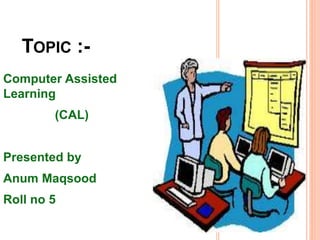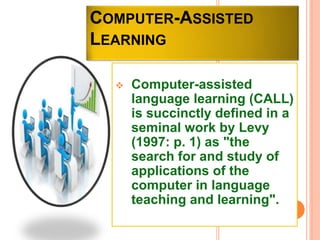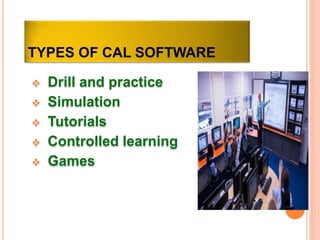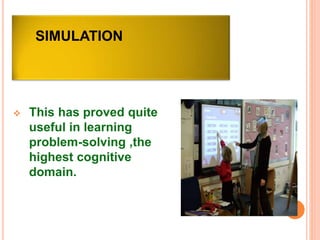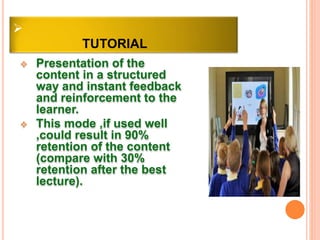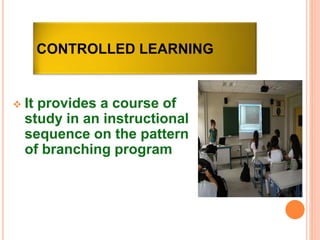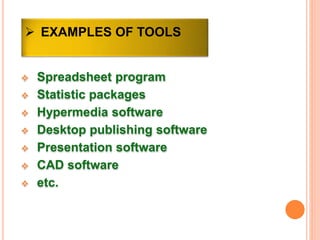Computer Assisted Learning
- 1. TOPIC :- Computer Assisted Learning (CAL) Presented by Anum Maqsood Roll no 5
- 2. COMPUTER-ASSISTED LEARNING ’üČ Computer-assisted language learning (CALL) is succinctly defined in a seminal work by Levy (1997: p. 1) as "the search for and study of applications of the computer in language teaching and learning".
- 3. ’āś PURPOSE :- ’üČ To assess the teaching process ’üČ To review and reinforce ’üČ To promote foundation mastery ’üČ To promote remediation ’üČ To motivational environment
- 4. TYPES OF CAL SOFTWARE ’üČ Drill and practice ’üČ Simulation ’üČ Tutorials ’üČ Controlled learning ’üČ Games
- 5. ’üČ Drill and practice is good for fundamental mastery.
- 6. SIMULATION ’üČ This has proved quite useful in learning problem-solving ,the highest cognitive domain.
- 7. ’āś TUTORIAL ’üČ Presentation of the content in a structured way and instant feedback and reinforcement to the learner. ’üČ This mode ,if used well ,could result in 90% retention of the content (compare with 30% retention after the best lecture).
- 8. CONTROLLED LEARNING ’üČ It provides a course of study in an instructional sequence on the pattern of branching program
- 9. ’āś TRADITIONAL TEACHING ’üČ A single teacher giving lectures to a group of students who are expected to use their notes and textbook to prepare for periodic examinations.
- 10. CAL TEACHING ’üČ Teacher Independent ’üČ Reduce work load ’üČ Time saving ’üČ Active learner ’üČ Advance ’ü▒
- 11. ’āś ADVANTAGES ’üČ Reduced the work load of teaching. ’üČ Improve motivation ’üČ Reach the large audience ’üČ Multiple dimensional learning ’üČ Promote interactive learning. ’üČ Builds confidence among students. ’üČ Provide immediate feedback.
- 12. ’āś DISADVANTAGES ’üČ It is a mechanical approach. ’üČ Mental and physical fatigue. ’üČ It is vary expensive. ’üČ None effective for some applications(e.g. reasoning) ’üČ Lack of infrastructure ’üČ Lack of knowledge ’üČ Lack of computer literacy.
- 13. ’āś EXAMPLES OF TOOLS ’üČ Spreadsheet program ’üČ Statistic packages ’üČ Hypermedia software ’üČ Desktop publishing software ’üČ Presentation software ’üČ CAD software ’üČ etc.

